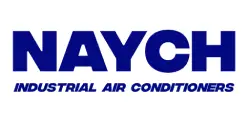
- Home
- NOTES
- THE WORLD’S MOST AGGRESSIVE WEATHER CONDITIONS
AGRESSIVE WEATHER CONDITIONS
REMINDER FOR YOUR THERMAL BALANCE CONSIDERATION
The world has been classified into different climate categories in order to better assess the constraints specific to each region. The KOPPEN – GEIGER map accurately represents this state of affairs.
When choosing a NAYCH industrial air conditioner, it’s important to take into account the local conditions in the region of installation.
This tool allows you to identify the limits of your systems’ operating conditions. It also enables you to anticipate the climatic risks associated with your systems.

Summury
Internal heat loads
Surface-to-volume ratio
Sun exposure
Constructive principle
Wind direction and altitude
Salt atmospheres
When we speak of a saline atmosphere, we’re referring to the presence of saline aerosols in the ambient air, often associated with coastal environments or near sources of salt water such as oceans. These aerosols contain particles of sodium chloride and other salts which can deposit on the metal surfaces of your air conditioner.
Sodium chloride, in particular, is highly corrosive to metals, and in the presence of moisture can initiate corrosion reactions that compromise the structural integrity and functionality of your air conditioner’s metal components. The resulting corrosion can lead to perforations, leaks and premature degradation of critical parts such as heat exchangers, condensers and refrigerant lines.
In addition, corrosion can also affect electronic components by damaging connections and causing short circuits, which can lead to control system failures and malfunctions.
So, in a saline environment, it’s imperative to choose an air conditioner with specific corrosion protection coatings, such as anti-corrosion coatings on coils and metal components, as well as corrosion-resistant materials for exposed parts. By investing in an air conditioner designed to withstand these harsh environmental conditions, you can extend the life of your equipment and reduce the maintenance costs associated with corrosion.
Cyclonic regions
In cyclone-prone regions, winds can reach extremely high speeds, sometimes exceeding 250 km/h (155 mph) during tropical storms or major hurricanes. These powerful winds exert considerable forces on structures and outdoor equipment, including air conditioners.
When a cyclone strikes, wind-blown debris can impact your air conditioner at very high speeds, causing major damage such as perforations in outdoor units, deformation of panels and supports, and even breakage of essential components. In addition, the dynamic pressure exerted by winds can cause structural deformation of your air conditioner, compromising its integrity and ability to operate efficiently.
To minimize these risks, it’s imperative to choose an air conditioner with sturdy construction and resistant materials, designed specifically to withstand the extreme conditions of cyclones. What’s more, professional installation and secure mounting are essential to ensure that your air conditioner remains safely anchored, even in the face of the strongest winds.
Sandy winds and dust
In desert environments or regions exposed to sandy winds, fine particles can be transported over long distances and settle on the surfaces of your air conditioner. These particles can quickly clog condensers and air intake grilles, reducing the efficiency of your cooling system. A clogged condenser can lead to system overheating, reduced cooling efficiency and increased energy consumption.
In addition, sandy winds often carry abrasive particles that can damage the body and paintwork of your air conditioner, resulting in aesthetic deterioration and reduced equipment durability.
What’s more, these particles can also penetrate the interior of your air conditioner, risking seizure of moving components such as fans, motors and other mechanical components, leading to breakdowns and malfunctions.
The wetlands
In tropical environments, where relative humidity can often exceed 70% or even 90%, air conditioners face significant dehumidification challenges. Excessive humidity can lead to increased condensation inside the air-conditioning unit, particularly on cold surfaces such as the evaporator. This condensation can reduce heat transfer efficiency, leading to a loss of cooling capacity and increased energy consumption. In addition, the build-up of water in the unit can encourage the growth of microorganisms, causing long-term damage to internal components and requiring increased maintenance.
Furthermore, high levels of humidity can lead to the formation of dew points in rooms, which can cause thermal discomfort and promote the growth of mould on exposed surfaces. In addition, condensation on moisture-sensitive materials can cause structural damage, such as wood rot or metal corrosion.
To mitigate these problems, it’s essential to choose air conditioners equipped with efficient dehumidification systems, capable of maintaining comfortable humidity levels in the conditioned space.
Altitude
As you climb in altitude, the air becomes less dense due to the decrease in atmospheric pressure. This reduction in air density can affect the operation of your air conditioner.
Reduced air density affects heat transfer in the air conditioner’s evaporator and condenser. With fewer air molecules available to transport heat, the heat transfer process can be compromised, which can also reduce the overall efficiency of your air conditioning system.
